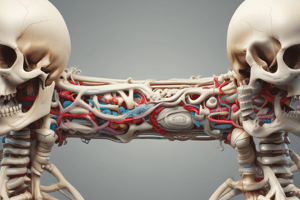Podcast
Questions and Answers
What are the functions of the vertebral column?
What are the functions of the vertebral column?
To support weight, protect the spinal cord, serve as an axis and pivot, and aid in posture and movement.
What are the segments of the vertebral column, and how many vertebrae are in each segment?
What are the segments of the vertebral column, and how many vertebrae are in each segment?
Cervical = 7, Thoracic = 12, Lumbar = 5, Sacral = 5, Coccygeal = 4
Describe the structure of the vertebral arch.
Describe the structure of the vertebral arch.
Formed by pairs of pedicles and laminae, creating a vertebral foramen/canal for the spinal cord, with superior & inferior vertebral notches forming intervertebral foramina.
Describe the different types of vertebral processes.
Describe the different types of vertebral processes.
What special characteristics are found in cervical vertebrae?
What special characteristics are found in cervical vertebrae?
What is another name for C1, and what special features does it have?
What is another name for C1, and what special features does it have?
What is C2 called, and what special features does it have?
What is C2 called, and what special features does it have?
What is another name for C7, and what is special about it?
What is another name for C7, and what is special about it?
What features are unique to the thoracic vertebrae?
What features are unique to the thoracic vertebrae?
What features are unique to the lumbar vertebrae?
What features are unique to the lumbar vertebrae?
What is unique about L5?
What is unique about L5?
What features are unique to the sacrum?
What features are unique to the sacrum?
What features are unique to the coccyx?
What features are unique to the coccyx?
Which of the normal curvatures of the spine are primary? Which are secondary?
Which of the normal curvatures of the spine are primary? Which are secondary?
What movements can occur at the vertebral column?
What movements can occur at the vertebral column?
What restricts movements at the vertebral column?
What restricts movements at the vertebral column?
Describe vertebral body joints.
Describe vertebral body joints.
What are uncovertebral joints?
What are uncovertebral joints?
Flashcards are hidden until you start studying
Study Notes
Functions of the Vertebral Column
- Supports body weight and provides structural stability.
- Protects the spinal cord, housing and safeguarding it.
- Serves as an axis for rotation and a pivot point for movement.
- Aids in maintaining posture and facilitating various movements.
Segments of the Vertebral Column
- Composed of 7 cervical, 12 thoracic, 5 lumbar, 5 sacral, and 4 coccygeal vertebrae.
Structure of the Vertebral Arch
- Formed by paired pedicles and laminae, creating the vertebral foramen.
- Superior and inferior vertebral notches create intervertebral foramina for spinal nerves.
Types of Vertebral Processes
- Spinous process: Located posteriorly, single per vertebra.
- Transverse process: Located posterolaterally, two per vertebra.
- Articular process (zygapophysis): Four per vertebra (two superior and two inferior) where pedicle meets lamina.
Special Characteristics of Cervical Vertebrae
- Contain transverse foramina for vertebral arteries.
- Feature anterior and posterior tubercles on transverse processes.
- Carotid tubercle located on transverse process of C6.
- Enlarged vertebral foramina accommodating cervical spinal cord.
- Uncinate processes on superior border of vertebral bodies.
C1 (Atlas) Features
- Known as the atlas; articulates with occipital condyles of the skull.
- Lacks a body; presents with anterior and posterior arches.
- Contains a groove for the vertebral artery on its superior surface.
C2 (Axis) Features
- Known as the axis; features the dens (odontoid process) for pivoting with C1.
C7 Characteristics
- Referred to as the vertebra prominens due to its long spinous process, prominent and palpable.
Unique Features of Thoracic Vertebrae
- Possess superior and inferior costal facets for rib articulation.
- Feature transverse costal facet for rib tubercle articulation.
- Long and slender spinous processes.
Unique Features of Lumbar Vertebrae
- Accessory process for muscle attachment on transverse processes.
- Mamillary process located between transverse and spinous processes.
- Large vertebral bodies, thick laminae, and short spinous processes.
Unique Characteristics of L5
- Largest vertebra, providing support for substantial weight.
- Contributes significantly to the lumbrosacral angle due to differential height in anterior vs. posterior aspects.
Unique Features of the Sacrum
- Contains a sacral canal housing the vertebral canal.
- Sacral foramina serve as exit points for nerves.
- Features include sacral promontory, median crest, medial crescent, lateral crest, sacral hiatus, and auricular surface for sacroiliac joint articulation.
Unique Features of the Coccyx
- Composed of a variable number of vertebrae.
- Cinematically features coccygeal horns articulating with sacral horns.
Normal Curvatures of the Spine
- Primary curvatures: Thoracic and sacral (present at birth).
- Secondary curvatures: Cervical and lumbar (develop as the child gains head control and starts walking).
Movements of the Vertebral Column
- Capable of flexion, extension, lateral bending, and rotation.
Restrictions on Vertebral Column Movement
- Elasticity of intervertebral (IV) discs acts as a primary restrictor.
- Orientation of zygapophysial joints, articular capsules, along with muscles and ligaments contribute to movement limitations.
Vertebral Body Joints
- Formed as secondary cartilaginous joints that articulate through intervertebral discs.
- IV discs comprise anulus fibrosis (tough outer layer) and nucleus pulposus (gel-like center).
Uncovertebral Joints
- Formed between uncinate processes of C3-C6 and the adjacent vertebral body above.
Vertebral Arch Joints (Zygapophyses)
- Establish synovial joints allowing for flexibility and motion between vertebrae.
Studying That Suits You
Use AI to generate personalized quizzes and flashcards to suit your learning preferences.



